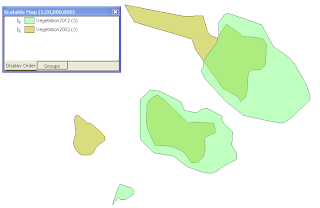
Identify the loss of vegetation
- In GeoMedia, select Analysis | Spatial Difference.
The Spatial Difference dialog box appears.
- In the From features in combo box, select the later vegetation polygon feature e.g. Vegetation2012.
- In the Subtract features in combo box, select the earlier vegetation polygon feature e.g. Vegetation2002.
- In the Output difference as Query name field, type in a meaningful string e.g. Loss of Vegetation since 2002.
- Optional. Click the Style button and set a thick border color e.g. red.
- Click OK.
The areas representing the loss of vegetation since 2002 are displayed in red.
Identify the new vegetation growth
- Select Analysis | Spatial Difference.
The Spatial Difference dialog box appears.
- In the From features in combo box, select the later vegetation polygon feature e.g. Vegetation2012.
- In the Subtract features in combo box, select the earlier vegetation polygon feature e.g. Vegetation2002.
- In the Output differences as Query name field, type in a meaningful string e.g. New vegetation growth since 2002.
- Optional. Click Style and set a thick green border color.
- Click OK.
The new vegetation growth areas are displayed in dark green.

No comments:
Post a Comment